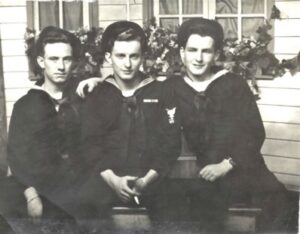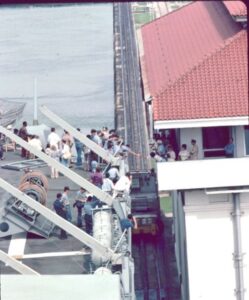by Sue Wolinsky, Family Member, Army IL National Guard
Navy Veteran Saw Hueys Tossed off USS Midway during SVN Evacuation
Do you remember where you were on April 29-30, 1975, when South Vietnam fell to the North Vietnamese and the US evacuated ~7,000 persons? This historic photo should jog your memory. But did you know that the USS Midway dumped helicopters from the flight deck to save a Vietnamese family fleeing SVN during the evacuation? Read on

Our VMFC member featured in this month’s Veterans Spotlight, Bob Kuning (US Navy, EW1), saw it firsthand. He has his own personal photos to document this part of the action. He was the Electronic Warfare Technician on the destroyer USS Rowan DD782 assigned to the US 7th Fleet. The USS Rowan escorted the aircraft carrier USS Midway. “When assigned as plane guard, we traveled ½-mile behind the Midway and picked up anything or anybody who fell overboard.
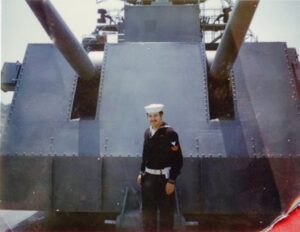
One time, we picked up a sailor who fell overboard while dumping trash off the fantail. After we retrieved him from the water, we took him back to our nearby homeport for medical treatment. Because of that, we got into port early and had a longer shore leave. We loved that part,” Kuning recalled.
Kuning was assigned to the USS Rowan because he was the only Electronic Warfare Technician who knew how to maintain and operate a special radio receiver for a recently deployed ship missile threat. “At sea, our job was electronic surveillance – we had a big band of old World War II tuners to intercept radars and record them for analysis for the Defense Intelligence Agency. The other part of our job was electronic countermeasures. We operated jammers specialized to keep incoming missiles from hitting the ship. It was really interesting work,” he said.
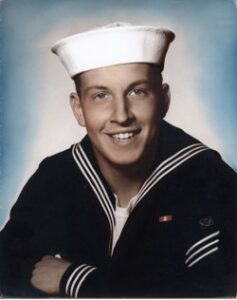
“I loved the electronic warfare training. This was a new rating, and we were trained to both operate and repair the equipment. There were a lot of openings and opportunity for promotions; that’s partly how I made it to E-6 so quickly. At 23-1/2, I was possibly the youngest guy to make E-6 in the Navy,” he said. Kuning was in the Navy from 1971 to 1977.
“The people making deployment assignments didn’t know what to do with us yet. It was almost two years before they sent us to the fleet, and me to the Rowan at Yokosuka, Japan (Kuning’s home base 1973-1975). The Rowan had just pulled into the yards for overhaul there. The ship spent a year in drydock there before I ever deployed to sea,” he explained.
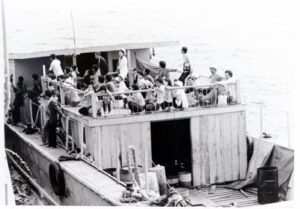
It was while Kuning was aboard the Rowan escorting the USS Midway during the US evacuation of South Vietnam at the end of April 1975 (Operation “Frequent Wind”), that the captain of the Midway ordered U-H1 Huey helicopters to be dumped into the sea. What Kuning heard resonates with him even today. “I was able to tune down into the aviation band. I heard Vietnamese pilot communications. I heard the desperation and fear in their voices as they searched for the fleet out in the vast open seas…. Then, two to three days later, we were vectored to an old surplus US landing craft dead in the water; the engines were down. The boat was filled with fleeing South Vietnamese. We pulled up, the machinist mates got the engines running again. We gave them charts, maps, and a compass, as well as directions on where to head for help (there was insufficient room on the destroyer to take them aboard). That gave me appreciation for the people trying to get into our southern border. This really brings it home,” he said, sadly. “Talk about a wing and a prayer.”
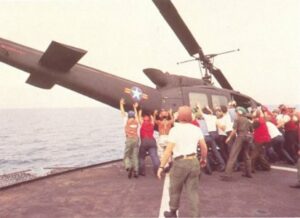
“The Midway alone rescued 3,000 refugees,” according to retired US Navy Rear Admiral Larry Chambers (the USS Midway captain at the time) in an interview in a 2021 article in Military Times ‘What’s happening now is worse’: Midway skipper who pushed choppers off deck in fall of Saigon (militarytimes.com). (Chambers had been asked to compare the ditching of helicopters in 1975 to the US’s abrupt departure from Afghanistan in 2021.)
“’In the ensuing hours, wave after wave of helicopters arrived from the mainland, a 75-minute flight away,’ Chambers recalled. ‘There were HH-53s loaded with 250 people, Hueys with 50,’ he said. ‘Soon the deck was filled with frightened men, women and children fleeing death at the hands of the swarming enemy,’” the article reported. “As the human misery unfolded, Chambers, the first Black aircraft carrier skipper, risked his career to help save those who helped the U.S. As Vietnamese Air Force Maj. Buang-Ly circled overhead with his family in a Cessna Bird Dog, dropping desperate notes on the deck, Chambers made a fateful and, as it turns out, historic decision. Despite being ordered to let Ly ditch into the sea, Chambers knew the man and his family would never survive. So he had his crew push millions of dollars worth of helicopters into the sea to make room for the small plane, which had no business flying over open water,” according to the article. “Chambers, who retired in 1984 as a rear admiral, said he knew he was risking a court-martial, but acted anyway. ‘I have to live with my grandmother yelling in my ear ‘do the right thing,’ Chambers said, explaining why he made that decision to save Ly and his family.’”
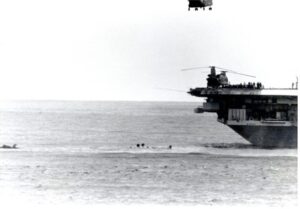
“So, then I saw our U-H1 (Hueys) being tossed off the back of the Midway,” Kuning said. “The Midway didn’t have enough room to store them all and the plight of those onboard the small plane affected all of us. It was ‘life lessons in the flesh’.”
|
SOME IRONIES:
|
POST-MILITARY LIFE: “My military career fed my future life choices. My training in electronics fed my education and career choices,” he said. “I worked three part-time electronics jobs while I earned my Associates Degree at my community college, and then transferred to Washington State University in Pullman, WA, and got my BSEE in electrical engineering (in 2-1/2 years). I worked in electronics for program product support, and as a Honeywell systems engineer in multiple full-scale aerial target programs creating drones from fighter aircraft – all of it in the Albuquerque area. Toward the end of my career, I worked as a Program Manager for various Foreign Military Sales programs, and as a Project Engineer for several Flight Management Systems.
“I met my wife, Patty, in a bar in Moscow, ID, at an IEEE “fluids lab” on a Friday after classes (the meaning of fluids lab should be obvious). I graduated half a semester ahead of her and was hired Albuquerque. After graduation, on her way to a job in Texas, I convinced her to stay in Albuquerque and seek work here. After some time together, we were married (40 years in July!). I’m happy to say, we are sharing our life together to this day. She’s a Mechanical Engineer and has worked in the aerospace industry at Honeywell as well. Since we both retired at age 55, she has opened a successful video business, Real Image Productions, here in New Mexico; I help with filming and sound.”

“The US evacuation out of Vietnam left its impact on me too,” he reflected, “but not til later. It was after the 2016 election that I cried, wiped my tears, and decided to get to work. I became a Democratic precinct chair and then a ward chair. I’ve also helped Democratic organizations with sound production in recent years. I realized when I got involved how much of a difference we could make if we could level the playing field for everybody. It’s not level, even now; especially now. I also learned Dems are overly optimistic; they think because their cause is just, that it will naturally progress without having to worry. Lazy; They don’t like to get out to vote. We have to get them motivated to vote. That’s what grassroots organizing is for. I’ve been organizing and protesting for progressive causes ever since,” Kuning concluded.
